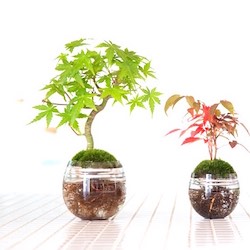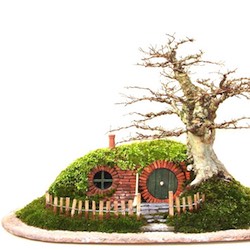In this article an attempt is made to explain the most commonly used Bonsai terminology, with a section on English botanical terms, Japanese styles / general terms and an explanation of Bonsai tools.
The list was put together by members of our Bonsai forum, with special thanks to Leslie, Pinkham, Bassand and Manofthetrees. This is an ongoing effort, in case you have anything to add, please don't hesitate to contact us!
English Bonsai terminology
ADVENTITIOUS BUD - any latent bud in the cambium layer activated by hormonal changes in the tree. These are undifferentiated cells until activated and may become branches, leaves, flowers, or roots, depending on a wide variety of environmental factors governing the growth of the plant.
AIR-LAYERING - a technique used to force a tree or branch to form new roots at a certain point (Air layering).
APEX - highest point of a tree which can be a single branch or a group of small branches.
APICAL - most vigorous growth produced by a tree generally at the furthest points of the tree from the root system such as the upper and outermost branches. "To be at the apex", refers to the apex only, not just any branch tips. Contrasting apical would be basal, referring to the base. Apical dominance refers to trees with the primary growth at the top (the bulk of trees). Basal dominance refers to trees with primary growth at the bottom (several dwarf cultivars of Acer p. are good examples here). Read more about apical dominance.
ARGILLACEOUS ROCK - A class of sedimentary rock containing clay components. Untreated, it breaks down fairly readily due to the absorption of water and subsequent swelling, then retracting and cracking into ever-smaller components. Akadama (literally; "clay soil from akadama region" - in the same way kanuma is "clay soil from kanuma region") is heated to a high temperature, which changes the crystalline structure of the clay - not unlike the process of creating bisqueware after forming creamics and before firing to vitrification temperatures..
BACK BUDDING - a technique used to encourage growth further back along the branch or trunk by pruning the terminal buds.
BOTANICAL NAME - the Latin name given to each and every plant the world over.
BUD BREAK - the point at which the bud has opened enough to show a green tip.
BUD BURST - the point at which the bud's contents unfurl; a new leaf appears.
BUD EXTENSION - prior to Bud Break, where the tiny buds have been on the branch since the previous year, begin to swell and extend.
BLEED - to weep sap.
BRANCHES - Primary branches grow directly from the trunk; Secondary branches grow directly from the Primary branches; Tertiary branches grow directly from the Secondary branches.
BROAD-LEAVED/CONIFEROUS - Conifers belong to the group of naked-seeded plants known as gymnosperms- their seeds are not enclosed in an ovary. The leaves of Conifers are needle-shaped or scale-like. All Conifers are "evergreen" with a few notable exceptions. Broad-leaved trees are a much larger group belonging to the angiosperms or flowering plants which have seeds enclosed in an ovary. Also know as "deciduous" trees, these go dormant in Autumn until Spring. Read more about Tree species.
BUD - organ or shoot containing an embryonic branch, leaf or flower.
BUTTRESSING - also known as the root-flare, the base of the tree flares outwards giving the impression of great age and solidity.
CAMBIUM - green growth tissue directly below the bark; it's increase adds to the girth of roots and stems.
CALLUS - tissue that forms over a wound on a branch or trunk as part of the healing process.
CANDLE - name given to the extending bud of a Pine tree before the new needles open.
CHLOROSIS - loss of chlorophyll as a result of mineral deficiency; this is what causes deciduous leaves to change color in Autumn.
CHOP - term used to describe a technique where heavy pruning and height reduction of the tree trunk takes place.
COMMON NAME - simply the name a plant is commonly known by however, common names can be very non-specific; i.e.: Maple could refer to any one of hundreds of trees and can vary from region to region.
CULTIVAR - a cultivated variety of a given species, for example the Acer palmatum "Bloodgood" or the Acer palmatum "Deshojo" are both Acer palmatum cultivars or varieties.
DEADWOOD - a special technique used to create deadwood on a Bonsai which enhances the character of and, ages the appearance of a tree.
DECIDUOUS - broad-leaved trees which harden off and shed their leaves in the Autumn followed by dormancy during the Winter.
DEFOLIATION - a technique involving the removal of all or most of a bonsai's leaves which reduces the plant's leaf size as well as the distance between internodes. Read more about Defoliation.
DESICCATION - state of extreme dryness, or the process of extreme drying
DIATOMATIOUS EARTH - a sedimentary soil produced by the shells/skeletons of diatoms, not volcanic activity (which is pumice) which is becoming more and more popular with Bonsai enthusiasts as a Bonsai soil replacement for Akadama.
DIE BACK - death of growth beginning at the tip due to disease or injury.
DISSECTED - deeply cut into segments or lobes.
ERICACEOUS - a term referring to acid-loving, lime-hating plants.
EVERGREEN - a plant that remains in leaf year round, slowly shedding old leaves while being replaced by new growth.
FORM - the main direction in which the trunk of a tree grows.
GENUS - a group of plants that belong to the same family of varying species; they share the first part of a plant's Latin name such as Acer palmatum.
GRAFT - a technique used to meld or attach a branch to the stump of a tree. Read more about Grafting.
INCH - Imperial Measurement replaced by Metric in the 1960's however, it is still in use today by some countries. One inch (1") equals 2.5 cm.
INDOOR Bonsai - tropical or sub-tropical plants that need to be kept inside in temperate climates where temperatures dip below 60°F (15°C). They may be placed outside during warm summer weather providing the night temperatures stay at or above 15 degrees C. Read more about Indoor Bonsai.
INTERNODE - the section of growth between two nodes (leaves or leaf-joints).
NODE - growth point on a branch or trunk from which leaves, leaf-buds and shoots can appear.
OVER-WATERING - watering too frequently and poor draining soil; decreases amount of air available to roots; can eventually lead to root-rot and death of a tree.
PEAT - organic soil component derived from rotted and broken down Sphagnum Moss; unpopular with Bonsai enthusiasts.
PETIOLE - the stalk of a leaf that attaches to the stem.
PHOENIX GRAFT - technique where a sapling is attached to deadwood.
PRE-Bonsai - a young tree that has not yet been trained.
PRUNING - most important method in training a Bonsai by pruning and trimming leaves and/or branches.
RAMIFICATION - repeated division of branches into secondary branches by means of pruning.
ROCK PLANTING - trees grown in or on rocks to create a dramatic visual appearance. Learn how to make a Bonsai rock planting.
ROOT FLARE - also know as the Nebari, the mound of exposed surface roots at the base of the trunk; provides visual balance. Read more about the Surface roots or Nebari.
ROOT OVER ROCK - a technique where the tree is planted over a rock with the roots extending downwards to reach the soil.
SEASONAL Bonsai - a species that look their best for only a short time when in flower or fruit.
SENESCENT - older; growing old.
SOIL - for growing Bonsai. a specialized soil is required which contains various mixtures of organic soil made from plants, peat, bark or leaf litter and, of inorganic soil containing stone, mineral or fired clay such as grit, sand, Akadama or turface. Read about Bonsai soil.
SPECIES - the sub-division of a Genus; the second name in the Latin terminology (Acer palmatum).
SPHAGNUM MOSS - general name given to a long fibred moss used as an organic soil component for Bonsai and air-layering; has a great ability to absorb and hold moisture.
STYLE - the way in which a Bonsai has been shaped in order to compliment the form (direction) of the trunk.
SUBSTRATE - the material on which a plant grows. Read more about Bonsai soil.
TERMINAL - apical; outermost tip.
TERMINAL BUD - a bud formed at the tip of a stem, twig or branchlet.
TREE - Bonsai growers will commonly refer to their Bonsai as trees rather than as bonsai.
TRUNK LEADER - uppermost branch on a previously cut off trunk that is trained to grow vertically as an extension of that trunk.
UNDER-WATERING - when a tree is allowed to dry out completely or, is not watered thoroughly when required.
VARIETY - the sub-division of species; the third name in Latin terminology (Acer palmatum "Deshojo"). Synonymous with "cultivar".
WIRING - a technique using wire to bend a branch or trunk in a certain direction thus training it to grow in that way. Read more about Wiring.
XYLEM - area below the cambium layer in a trunk.
Japanese Bonsai tree styles
BANYAN - a tree style requiring dramatic, exposed roots that grow from branches and trunk while reaching down to the soil.
BUNJINGI (Chinese) - literati form
CHOKKAN - formal upright form
FUKINAGASHI - windswept form
HAN KENGAI - semi-cascade form
HOKI DACHI - broom form
IKADABUKI - raft form
KENGAI - cascade form
LITERATI - Bonsai tree form with tall, slender trunk, no lower branches, and sparse foliage confined to the top of the tree.
MOYOGI - informal upright form
SHAKKAN - slanting form
Continue reading about Bonsai styles.
General Japanese Bonsai terms
AKADAMA - (literally; "clay soil from akadama region" - in the same way kanuma is "clay soil from kanuma region") is heated to a high temperature, which changes the crystalline structure of the clay - not unlike the process of creating bisqueware after forming creamics and before firing to vitrification temperatures.
BONKEI - tray landscape containing rocks, small accent plants and trees.
ISHISUKI - planted on rock.
JIN - removal of bark on a branch to create deadwood.
KABUDACHI - multiple trunk
MAME (豆), "bean" in Japanese. Refers to bonsai under 2-3" (6-8cm) tall. There's a sub-class of mame called "shito" or "fingertip", which are typically the tiniest of 1" (2-3cm).
NEBARI - root mound/flare; exposed root form.
NETSUNAGARI - root connected.
PEN-JING (Chinese) - landscape planting.
POTENSAI - potential Bonsai
SABAMIKI - split trunk
SAI-KEI - landscape planting
SANKAN - triple trunk
SEKJOJU - root over rock.
SHARI - technique used to create deadwood on trunk.
SHARIMIKI - driftwood
SHIDARE ZUKURI - weeping
SHOHIN - "tiny things" in Japanese. Name given to Bonsai trees less than 6" (15cm) in height.
SOKAN - twin trunk.
SUIBAN - shallow water tray for display rock plantings.
TANUKI - form where sapling is attached to deadwood; also know as the "Phoenix Graft".
TOKONOMA- traditional Japanese display area in home.
TORIKI - propagation technique known as "air-layering".
TSUGIKI - graft
URO - hollow parts of the trunk, when wood rots away
YAMADORI - material collected from the wild.
YOSE UE - forest planting.
A very special thank you to the members of the Bonsai Empire forum for their effort to put together this Bonsai terminology guide, as well as to Harry Harrington for granting permission to use his website article for some of the above definitions.




